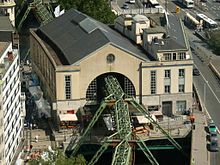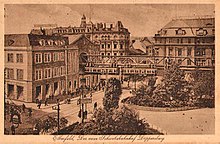Köbo house
The Köbo-Haus , together with the main railway station suspension railway, is a listed building at Alten Freiheit 26 in the Elberfeld district of the city of Wuppertal . It is the only house in the city that is built over the Wupper .
description
The northerly part of the heavy and bulky acting building complex in the style of classically stained Modern is composed of the two-storey Schwebebahnhof, a massive, elongated construction with flat inclined verschiefertem saddle roof, and the four-storey KÖBO , business-to a trapezoidal ground plan on the southern longitudinal side together . The building is plastered, including the previously unplastered ground floor of the suspension railway station. The part of the suspension railway station is essentially determined by the central, arched western and eastern entry and exit openings on the front sides. The tall rectangular, narrow window cuts continue in the commercial building as rows of window axes made of square formats.
history
Originally, the Art Nouveau train station, built in 1900 and popularly known as the “bathtub”, was located on the same site . In the 1920s, it could no longer cope with the steadily increasing number of passengers, and the construction was also perceived as annoying and ugly. On the occasion of the planning in 1923 for the construction of an exhibition hall to the south and within the framework of the “development plan for Brausenwerther Platz”, the avant-garde steel frame building was to give way to a massive station building with a commercial building, for which the Elberfeld Building Department had clear guidelines in graphic form. A competition was announced for the redesign of Brausenwerther Platz .
Using the results of this competition, the Barmer architect Clemens Julius Mangner created a design that was finally implemented in 1925/26 by Siemens-Bauunion from Berlin. According to Mangner's plans, a commercial building was added to the side of the station and named after the main tenant - the long-established car dealer Köhler & Bovenkamp - Köbo-Haus , who ran a car dealership with the brands Mercedes, BMW and GM here. In addition to offices and medical practices on the ground floor, the building housed a number of shops. In addition to a restaurant, a café and the tourist office, several shops were also housed in the passage of the station.
After the destruction of World War II , as part of the urban redesign of the traffic management on the former Brausenwerther Platz, Bundesstraße 7 interrupted the historical structure on Döppersberg from the 1950s / 60s , with the Köbo house protruding like a wedge into the street. In the 1980s, the city-owned building was completely dilapidated, but was listed on February 15, 1991 (monument number 1868). From 1991 onwards, the existence of individual suspension railway stations and, above all, that of the Köbo-Haus was controversial. In the run-up to the general renovation and new building planning, the discussion related particularly to the monument value of the building complex, which was also considering demolition. Since 1995 the Döppersberg police station has been in the Köbo-Haus , which is Wuppertal's busiest police contact point.
In 2014, the Köbo-Haus was taken over by a company founded specifically for this purpose, which is close to the investor Signature Capital . The parties have agreed not to disclose the purchase price. The building is part of the renovation work on Döppersberg , which began in 2010 and is expected to be completed by the end of 2018. The rental contracts in the house for the police station and the Café Cosa of the addiction help will expire at the end of 2017. From January 2018, the investor will renovate the Köbo house until the end of the year, with additional shops and rooms for gastronomy being created. The apartments on the top floor of the building are to remain.
Trivia
In the film Pina from 2011, the building provided "a striking backdrop".
Web links
- Entry in the Wuppertal monument list
Individual evidence
- ↑ a b Wuppertal nicknames: The KöBo house is full of special features. In: Westdeutsche Zeitung of January 14, 2010
- ↑ a b c d e f Entry in the Wuppertal monument list
- ↑ a b c Hermann J. Mahlberg : Complete suspension railway. ( Memento of the original from September 20, 2017 in the Internet Archive ) Info: The archive link was inserted automatically and has not yet been checked. Please check the original and archive link according to the instructions and then remove this notice. In: architektur-wuppertal.de
- ↑ The suspension railway. The Wuppertal landmark. In: bahnen-wuppertal.de
- ↑ a b c Kurt Schnöring: Wuppertal in old views. Volume 2. Peter Hammer Verlag, Wuppertal 1981. ISBN 978-9-02885-479-6 . P. 45.
- ↑ a b Köbo house - the wrong house in the wrong place! In: njuuz, Sander, Schrader & Stötter Nachrichten GmbH of April 2, 2014
- ↑ "Close to 100 percent". In: Wuppertaler Rundschau from February 2, 2017
- ↑ Stefan Melneczuk: The Köbo house has been sold: More space for shops. In: Westdeutsche Zeitung of March 28, 2014
- ↑ a b Completion at the end of 2018. Stage goal achieved in the renovation of the Döppersberg. In: Remscheider General-Anzeiger from July 25, 2017
- ↑ The right to the city. In: Talwärts from May 22, 2015
- ^ Jeanette Wölling, Lothar Leuschen: Work on the Döppersberg is progressing. In: Westdeutsche Zeitung of April 7, 2016
- ^ Film city of Wuppertal. In: filmstadt-wuppertal.de
Coordinates: 51 ° 15 '21.3 " N , 7 ° 8' 54.7" E




